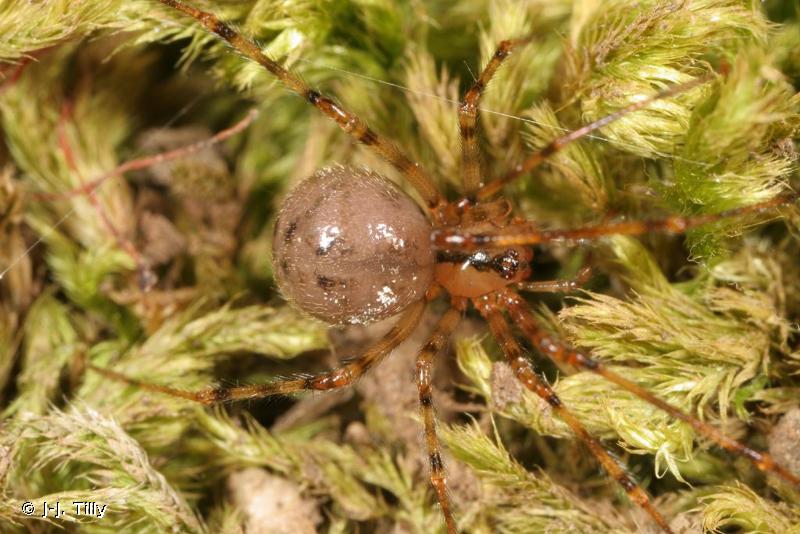
cd_nom

| Author : S. Déjean |
 |
To get the picture, please visit:
Despite the Creative Commons license, please inform the author of the use which will be made of his photo

| Author : J-J. Tilly |
 |
To get the picture, please visit:
Jean-Jacques Tilly
Association française d'Arachnologie
http://asfra.fr/Site/Main_public.html
email : inpn@mnhn.fr
Any reuse of one or more photographs on this site is subject to an authorization request from the author.
Link to the Code of Intellectual Property (Legifrance)
Distribution mondiale
toute l'Europe
Caractères distinctifs, espèces
Taille - femelle : 5-6 mm, mâle : 4-5 mm.
Les yeux latéraux sont accolés, les médians antérieurs plus petits que les autres. La coloration de l'espèce est assez typique : avec un céphalothorax clair marqué d'une fine bande noire latérale et d'une large bande noire médiane aux bords sinueux. L'abdomen est jaunâtre, marqué de taches noires de formes variables, formant des cellules claires plus ou moins nettes, d'où son nom. Les pattes jaunes sont annelées de noir. Il existe deux espèces dans le genre, l'autre espèce : N. eremita est plus petite et cantonnée aux milieux souterrains.
Milieux colonisés
L'espèce colonise des milieux sombres et humides, qui peuvent être des milieux rocheux ou anthropiques (cavernes, rochers, fossés, sorties d'eau) et aussi des milieux naturels telles les bordures d'étang, sous les touffes de végétation, ou encore sous les troncs couchés de forêts humides.
Chasse
L'espèce construit une toile en nappe, suspendue dans le milieu. Cette toile est en partie collante. Les proies interceptées, et en partie immobilisées, sont engluées par l'araignée, puis mordues. Les victimes sont déplacées vers un point retraite et consommées.
Développement, cycle
Les adultes sont présents presque toute l'année, les mâles manquent en automne et en hiver. Le cycle est annuel ou non soumis aux cycles saisonniers. Le mâle effectue une danse nuptiale par des tapotements sur la toile. La ponte a lieu en été. La femelle porte le cocon, sphérique, recouvert de soie parcheminée jaunâtre, attaché aux filières. Lorsque les jeunes sont prêts à sortir, elle suspend le cocon dans la végétation, puis les jeunes sortent sur la toile maternelle.
A. Canard(Université de Rennes/Service du Patrimoine Naturel, MNHN),2014
Continental
Metropolitan France
Overseas
Marine
Metropolitan France
Overseas
The map presents a summary at the 10 x 10 km grid of the observation data for the species transmitted to the SINP. These data have been subjected to validation filters.
The map presents a reference distribution layer of the species at the scale of departments and marine sectors. The presence and absence data were established by expertise within a network of partners. This reference distribution is used in the validation process of the SINP data at the INPN level.
Corresponds to a report on the basis of at least one observation proved within a period of 10 years (20 years for little-known invertebrates) preceding the year and no presumption of extinction since obtaining the last data nor doubt on reproductive and implemented nature of this population. For migratory species, the presence indicated concerns areas of reproduction.
This status is based on one or more of the following criteria:
This point covers the absence, more difficult by nature to demonstrate than presence. This status is based on one or more of the following criteria:
This status must be assigned to a department in which the presence of the species is casual.
Particular case of absence due to a proven extinction less than a half century ago (older disappearances are treated as "no probable or definite").
In the state of knowledge, we can not comment on the presence or absence in the current department. This is the default status when not comprised in one of the previous categories or whenever there is doubt.
The map shows the global distribution of the species based on GBIF data (Global Biodiversity Information Facility).
